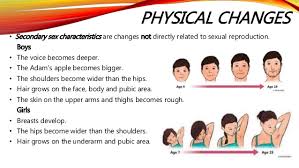The period between childhood and youth is called teenage. This period of transition from childhood to adulthood is also known as Adolescence. During this time physical, bio-chemical, and emotional changes has been accelerated. Our weight, height and even our physical structure also changes. This is a time period between 12-18 years of age.
The extremely rapid and sudden
increase in growth rate during this time is known as growth spurt. The growth
spurt of boys is slower than that of the girls. Several physical changes
occur in our body followed by several physiological changes as well. The
limitation of menstrual bleeding in adolescent girl is a significant change
that create a tremendous nutritional demand.
Just have a look : physical changes in puberty
The Nutritional requirements of adolescents:-
v Energy: As
growth rate increases, the calorie requirement also increases. Girls generally
require fewer calories, although individual demands vary. The appetite usually
in boys, increases and so it is usually not difficult to meet the high calorie
demand.
v Protein: The protein needs represent 11-12% of energy intake. The
protein intake usually exceeds 1gm/kg body weight. This meets growth needs and
for the pubertal change in both the sexes and for developing the muscle mass in
boys. The protein requirement in girls, between 10-12 years, is higher compared
to boys. High biological value protein should be given.
v Fats: Essential
fatty acids should be given to the adolescent which should provide at least 3%.
The desirable level for the visible fat intake for adolescents is 20 gm/day. α – linoleic acid is beneficial to reduce abdominal pain during
menstrual periods and helps to relax muscles.
v Minerals: Calcium and
phosphorus ratio of 1:1 should be maintained. Bone growth especially in boys,
requires large amount of calcium. Iron is needed for blood formation. Girls
loses about 0-5 mg iron/day during menstruation and for this iron supply is
necessary through the diet. Zinc is also necessary for pubertal growth.
v Vitamins: All the fat soluble vitamins are required according to
the RDA. Vit D is especially required for skeletal growth and calcium
metabolism. The ‘calorigenic vitamins’ i.e B1, B2 and niacin have to be supplied according to
the energy intake. Folic acid and vit.B12 are needed for DNA
synthesis since there is rapid cell division in adolescence due to the growth
spurt. Tissue growth requires amino acids for which protein metabolism is
needed. B6 helps in protein metabolism and also helps to reduce
premenstrual stress in adolescent girls.
Other general dietary intake:
· A well
balanced nutritious food should be given to the adolescent which does not
contain other excess or deficient quantities of nutrient, to prevent obesity
and underweight respectively.
· Regular
meal time should be maintained and skipping of meal time should be avoided.
· Junk and
fast foods should be avoided.
· Foods
should be made attractive and appealing.
· Media
influence and emotions should not guide food intake.
· Physical
activity should be encouraged.
Eating Disorders of adolescent:
1. Anorexia Nervosa: It is a condition marked by extremely low intake of food. It is an eating disorders that make people lose more weight that considered healthy for their age and height. People with this disorders may have an intense fear of weight gain. It is mostly common in the adolescent girls.
Signs and symptoms:
· Rapid loss
of weight
· Loss of
menstrual periods
· Nausea,
vomiting, constipation or bloating after eating normal amount of food.
· Lanugo
(hair on arms, legs, cheeks)
· Refusing to
eat, denying hunger
· Avoiding social
invitations to avoid food
· Depression,
mood swings
· Low
self-esteem
· Fatigue and
Weakness
· Obsessed
with exercising
Prevention and
Treatment: Since this is mainly a physiological problem, generally
nutrition counselling is necessary. Correct ideas of food should be given to the
patient and correct selection of food should be taught. Anorexia, bulimia and
binge-eating can only be corrected if the patient himself/herself is motivated.
2.
Bulimia Nervosa: In this
condition the person binges on food followed by purging or consuming a large
amount of food in a short time followed by an attempt to rid oneself of the
food consumed (purging), typically by vomiting, taking or laxative or diuretic
and/or excessive exercise.
Signs and symptoms:
· Weight
fluctuations
· Calluses
(Calcified tissue on the back of hands)
· Dental
enamel, erosion and cavities
· Fatigue or
Weakness
· Irregular
menstrual periods
· Hiding
eating from other
· Avoiding
social invitations
· Depression,
loneliness, feeling of emptiness
· Alcohol or
drug abuse.
3.
Binge Eating Disorders: This is characterized
by sudden periods of excessive eating followed by periods of extreme dieting.
Usually the patients are obese.
Signs and Symptoms:
· Trying to
avoid physical activities
· Depression,
Loneliness, guilt emotion problems
· Feelings
out of control when eating and being unable to stop
· Being
preoccupied with food
· Having low
self-esteem








Comments
Post a Comment
if you have any dobt , let me know